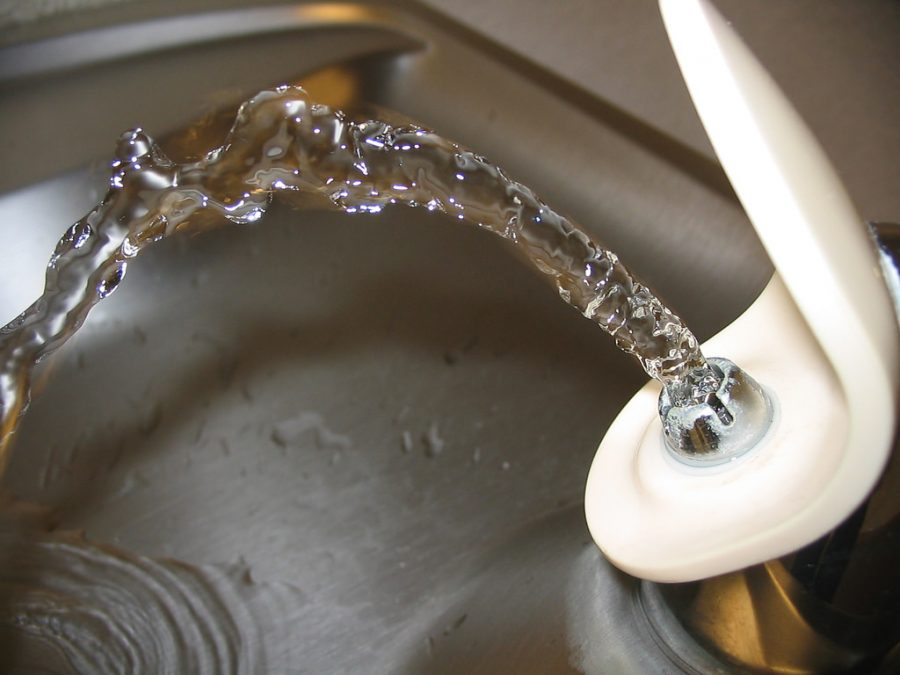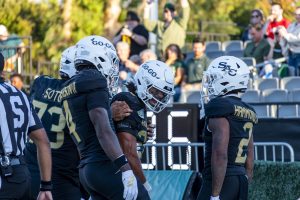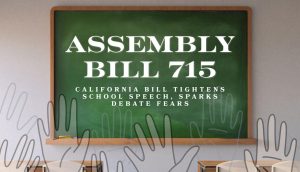Lead contamination of campus water goes back further than previously indicated
March 2, 2017
(Slide through timeline for more information on the lead problem on campus)
The issue of water contaminated with lead coming from Sacramento State’s drinking fountains and faucets goes back longer than the university had previously indicated, and a second phase of testing is set to begin.
Though the campus community was first notified of potential lead contamination in drinking water on January 25 of this year, the university was made aware in August after a small sample size test in March of 2016 that lead contamination was a possibility.
Jeffery Foran, a professor and chair of Sac State’s department of environmental studies, said that he and a group of colleagues and students first tested approximately 30 drinking water sources on campus in March 2016, now a year ago.
Following that round of testing, Foran, a professional toxicologist with a Ph.D., sought and was given permission to test for lead contamination in the water sources of the ASI Children’s Center that October, which he called a “susceptible population and a sensitive subpopulation.”
Risk Management, according to Sac State, also performed testing of the Children’s Center. No sources were above the EPA action limit of 15 parts per billion, with the highest being at 11 ppb according to Foran. It is known and admitted by Sac State that children, as well as pregnant women, are more susceptible to lead poisoning than adults.
Foran said he does not know what happened to the water sources in the Children’s Center, as he was told his group would not be allowed to return, though he was told they would remediate the situation. Indeed, Sac State said that the bubblers of three water sources were being replaced.
It was also at this time that Foran was told Sac State President Robert Nelsen was aware of the situation, and Foran was meeting regularly with members of the risk management department on campus.
Foran said that following that, in the fall semester of 2016, risk management and Steve Leland, the director of environmental health and safety, indicated to Foran that they would welcome him and his team to do more comprehensive testing. After Foran submitted a proposal in December, Sac State approved it January 3 and provided “about $4000” funding for such testing to the group, according to Parker.
This account clashes directly with the earlier assertion of Leland, who said multiple times that the testing of 449 sources over winter break was solely based in the study group’s interest.
The results of that widespread testing have been known since the first week of the spring 2017 semester. 58 water sources had lead levels above five parts per billion, the bottled water limit set by the Environmental Protection Agency.
Those were shut down by Sac State out of an “abundance of caution,” said both Leland and Jill Parker, the interim senior director for risk management services and chief risk officer.
27 water sources were above 15 parts per billion, which is the EPA action level, meaning they legally must be shut off.
Additionally, the university sent out an email last week saying that after recent testing, all food establishments on campus have water sources under the EPA action level or the FDA bottled water standard of 5 pbb. That testing was completed by UEI, as it owns the restaurants.
Now, according to Foran, the university has chosen to disregard his advice and forego any more testing by his group of colleagues and students, for reasons he does not understand.
Foran said the only responsible standard to use in his view is the California Public Health Goal, .2 ppb. He claimed to have communicated this importance to the university multiple times, without success.
“(Sac State) has focused solely on the 5 part per billion number, and at times on the 15 part per billion number, neither of which is designed to protect public health,” Foran said. “There’s a long history of how the FDA comes up with those levels and public health is only one of a variety of considerations.”
Foran said the state of California established a goal of a .2 ppb level of lead in drinking water “based on very sound and very good scientific information,” and that it is, if observed, virtually guaranteed to present no danger to the public.
“There are individuals who are drinking water on this campus (with) unacceptable concentrations of lead,” Foran said.
Added on to this assertion is that reportedly 10 percent of drinking water sources on campus are currently untested, and unlisted to the public. Parker said the administrators working on the issue know where these sources are, but don’t want to list them until they are tested.
“In my view, it is not prudent to assume a problem when you don’t know one exists,” Parker said. “You’re making an assumption, that in this one area, that same set of circumstances would apply to others. That’s a pretty big leap.”
According to Foran, knowing where the untested sources are isn’t easy because the testing group was never provided with a comprehensive list of water sources on campus in the first place; the group made one on its own, and suspected it to be incomplete from the beginning.
Foran’s biggest concern of the untested sources is the American River Courtyard residence halls. When the testing group arrived there, it was told by officials that the suite dorm rooms could not be tested because residents were currently living there.
With that knowledge, Foran said Parker’s quote about the untested sites floored him.
“I was stunned by that, because all of our data in its entirety suggests that there are problems there, and there’s no reason to think those dorms are different,” Foran said. “They should’ve been sampled, quite frankly, immediately after we found such widespread lead contamination.
“It’s unconscionable to think that students are still drinking water from those fountains or faucets, whatever they have in those buildings, that have not been tested.”
Parker said that all of the untested sources, including dorms and suites in the American River Courtyard, are set to be tested in the second phase, which is beginning today and being administered by CIH Services.
Parker, who joined Sac State in her role this February, said that she wants the remainder of the process to be handled at a professional standard, with an impartial testing agency. That is why, after Alex Spataru was hired by Leland to consult the university, another group, CIH, was hired by Parker after Spataru’s recommendation came in.
Foran said that after speaking to Spataru during his time on campus, he came away with the expectation that Spataru would recommend that the university place water filters on every drinking fountain on campus.
Sac State, under the direction of Parker, is choosing not to do so just yet without more comprehensive water testing.
Parker said at the time of the hiring that her goal was “using all professional standards in the profession of sampling, for occupational exposure, to make a definitive determination of what the water levels are first.”
Foran believes that this step being taken by Parker and the university is unnecessary for multiple reasons.
“We used standard EPA certified technology and techniques; we followed EPA certified quality assurance quality control programs, and the laboratory that did our analysis is in a EPA certified laboratory,” Foran said. “There’s nothing they would do differently than what we did. Why the university wants to do that is beyond me.”
The original group that tested the 449 drinking water sources has remained ready and willing to comprehensively test, according to Foran. His initial expectation was that they would be asked to do the second phase of testing, but the request never came. So the group waited, and so did Foran; an expert in every sense who has been told he is no longer needed.
Parker maintains that an impartial group of certified testers need to be brought in for the remainder of the process, and that the priority needs to be finding where on campus there are drinking water sources above the action level.
“I think it’s great that there is a goal that is lower than what the current regulatory standard is, but there has to be practical ways of achieving that goal, and until there are, that’s why we have regulations, to set the bar for what the expected community standard is,” said Parker.
Foran feels differently.
“To me, the bigger issue here is that there are something on the order of almost 380 fountains and faucets on this campus that have lead concentrations above the California Public Health Goal,” Foran said.
“And that’s a profound issue.”
This story was updated on March 8 at 2:38 to reflect that:
- The ASI Children’s Center is operated by Sacramento State, not University Enterprises Inc.
- The EPA’s action level for water is 15 parts per billion, while the FDA’s bottled water standard is 5 parts per billion.
- The proposal for comprehensive water source testing was submitted in December, but not approved until January 3.

























































































































Ashley • May 7, 2017 at 8:13 am
Thank you for publishing this article. I am an environmental studies major at Sac State, and this really concerns me. I am not understanding why it doesn’t seem to be a high priority issue like Dr. Foran was stating in this article. I wonder if the majority of Sac State students are aware of this issue?